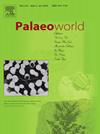Biogeographic dynamics of graptolites during the Late Ordovician Mass Extinction in South China
IF 1.7
3区 地球科学
Q2 PALEONTOLOGY
引用次数: 0
Abstract
Studying the temporal and spatial distributions and dynamics of fossils is crucial for understanding macroevolution processes in geological history. Biodiversity data provide an overview of faunal changes during extinction events, but it cannot differentiate the impact of extinction events on different species. Biogeographic study complements these data by offering more detailed insights into evolutionary patterns. A dataset of 704 graptolite occurrence records for the Late Ordovician Mass Extinction (LOME) was compiled from 60 localities in South China. The geographic distributions of 26 species across four graptolite biochrons (from late Katian to Hirnantian) were quantitatively reconstructed using ArcGIS. Two types of geographic range indexes, including convex hull areas and maximum distribution distances, were calculated for each species in each time slice. Based on the variations in the geographic ranges, the graptolites can be divided into three types. The geographic ranges of the first type shrank before the extinction, that of the second type expanded before the extinction but shrank during the extinction, and that of the third type expanded during the extinction. The first two types include Diplograptina species; and the third of Neograptina species. The study revealed that the extinction event affected all diplograptid graptolite species, as evidenced by the rate of decrease in geographic ranges. Interestingly, the impact of the major extinction appeared to be uniform across all graptolite species, irrespective of their initial geographic range size. The distribution centers of the graptolite species remained relatively stable and predominantly surrounded the center of the sea during the LOME. The substantial reduction in the geographic ranges of diplograptid species might be due to the global factors rather than local sea level decline.
华南晚奥陶世大灭绝期间爬行动物的生物地理动态
研究化石的时空分布和动态对于了解地质史上的宏观进化过程至关重要。生物多样性数据提供了灭绝事件期间动物变化的概况,但无法区分灭绝事件对不同物种的影响。生物地理学研究是对这些数据的补充,可以更详细地揭示进化模式。我们从华南地区的 60 个地点收集了 704 条晚奥陶世大灭绝(LOME)期间的爬行动物记录。利用 ArcGIS 定量重建了 26 个物种在 4 个爬行动物生物群(从晚加氏期到平南期)中的地理分布。计算了每个时间片中每个物种的两种地理分布指数,包括凸壳面积和最大分布距离。根据地理范围的变化,爬行动物可分为三类。第一类的地理范围在大灭绝之前缩小,第二类的地理范围在大灭绝之前扩大,但在大灭绝期间缩小,第三类的地理范围在大灭绝期间扩大。前两类包括 Diplograptina 物种;第三类包括 Neograptina 物种。研究显示,从地理范围的缩小速度来看,大灭绝事件影响到了所有双龙类爬行动物物种。有趣的是,大灭绝对所有爬行动物物种的影响似乎是一致的,无论其最初的地理范围大小如何。在大灭绝期间,爬行动物的分布中心保持相对稳定,主要环绕海洋中心。双龙类物种地理分布范围的大幅缩小可能是全球因素造成的,而非局部海平面下降。
本文章由计算机程序翻译,如有差异,请以英文原文为准。
求助全文
约1分钟内获得全文
求助全文
来源期刊

Palaeoworld
PALEONTOLOGY-
CiteScore
4.00
自引率
5.90%
发文量
95
期刊介绍:
Palaeoworld is a peer-reviewed quarterly journal dedicated to the study of past life and its environment. We encourage submission of original manuscripts on all aspects of palaeontology and stratigraphy, comparisons of regional and global data in time and space, and results generated by interdisciplinary investigations in related fields. Some issues will be devoted entirely to a special theme whereas others will be composed of contributed articles. Palaeoworld is dedicated to serving a broad spectrum of geoscientists and palaeobiologists as well as serving as a resource for students in fields as diverse as palaeobiology, evolutionary biology, taxonomy and phylogeny, geobiology, historical geology, and palaeoenvironment.
Palaeoworld publishes original articles in the following areas:
•Phylogeny and taxonomic studies of all fossil groups
•Biostratigraphy, chemostratigraphy, chronostratigraphy
•Palaeoecology, palaeoenvironment and global changes throughout Earth history
•Tempo and mode of biological evolution
•Biological events in Earth history (e.g., extinctions, radiations)
•Ecosystem evolution
•Geobiology and molecular palaeobiology
•Palaeontological and stratigraphic methods
•Interdisciplinary studies focusing on fossils and strata
 求助内容:
求助内容: 应助结果提醒方式:
应助结果提醒方式:


